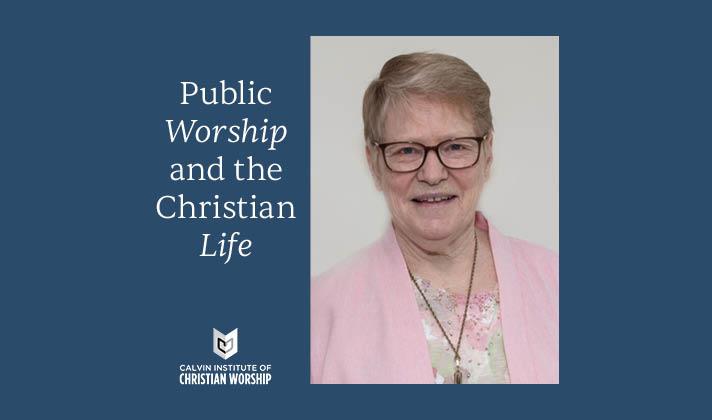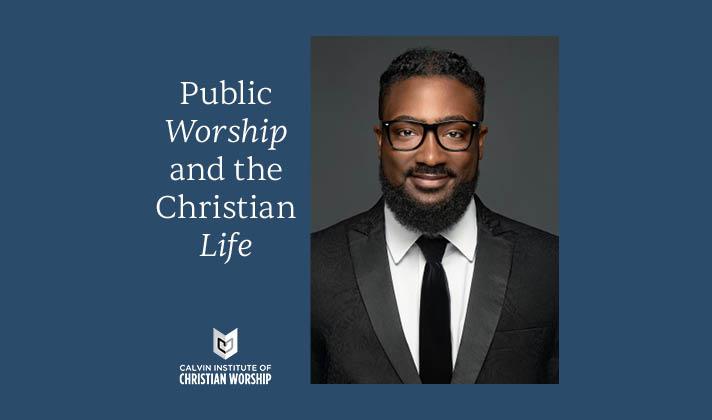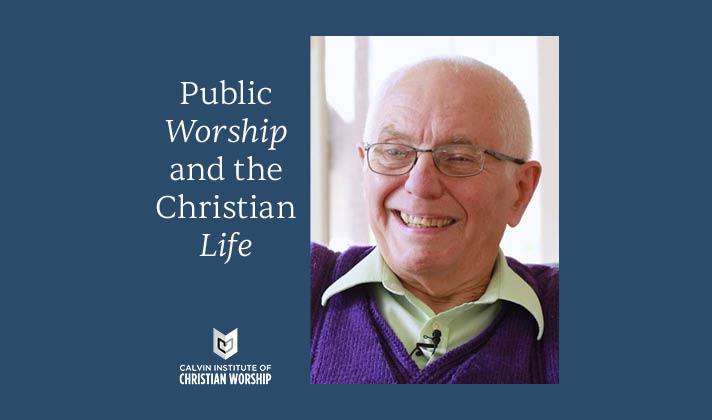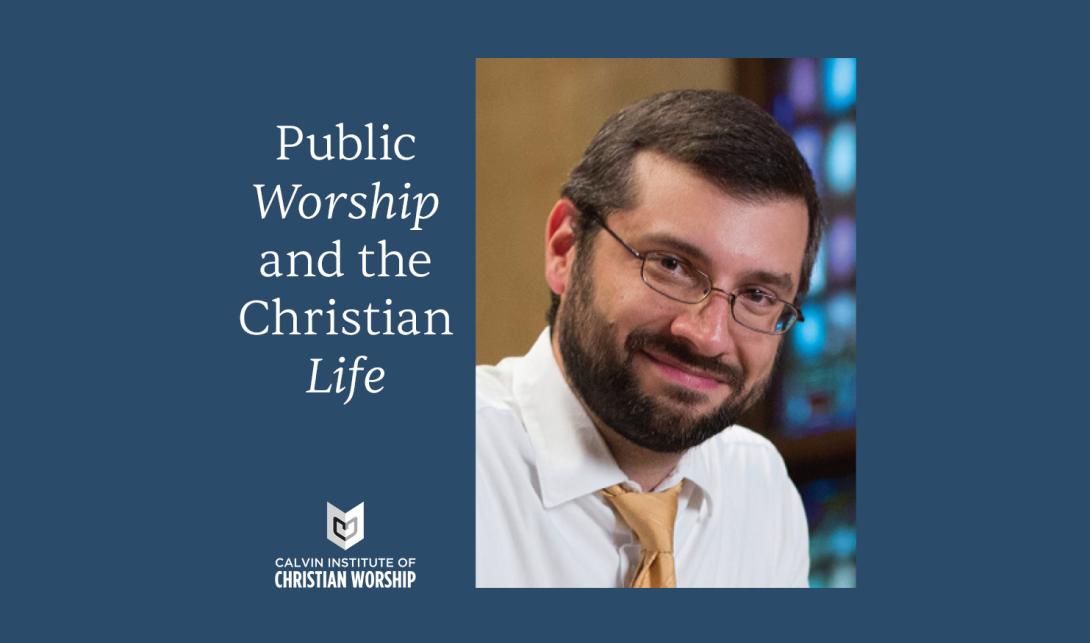Episode Transcript:
Lamar Hardwick 00:05 I felt like we can't really have a conversation about diversity unless we include that group—and really start with that group. And so I wanted the church to be on the forefront of adding disability to that discussion as many churches are seeking to become more diverse. I wanted that to be a theme, but then also to be able to celebrate and appreciate the beauty of all types of minds and bodies being full participants in the local church.
Kristen Verhulst 00:41 Dr. Lamar Hardwick is lead pastor at Tri-Cities Church in East Point, Georgia. He writes and speaks on the topic of disability and is the author of the bestselling book I Am Strong: The Life and Journey of an Autistic Pastor. His recent book is Disability and the Church: A Vision for Diversity and Inclusion and the topic of our conversation today. I'm Kristen Verhulst, your host of this episode of Public Worship and the Christian Life, a podcast by the Calvin Institute of Christian Worship. Find us at worship.calvin.edu.
Pastor Lamar Hardwick, I’m so delighted to have you on the podcast today. And I'm very eager to share with our audience the learning from your book, Disability and the Church: A Vision for Diversity and Inclusion. Would you be willing, Lamar, to introduce yourself to our audience? Some people may be aware of your work, and for others this will be brand-new.
Lamar Hardwick 01:53
Thanks for having me. I think probably the best way to describe my work is for those who have never heard of me before. Most people online know me as an autism pastor. There's a long story about that. I didn't actually come up with that name. It was from a parent who, long story short, messaged me very early on in my ministry and said I was like the pastor for the autism community, because many of them weren't able to get out and go to church. And so I would pastor them through . . . before Zoom was cool I was doing that and praying for them and working with them. And so that's where that came from. But that's also because I am late-diagnosed. I was diagnosed at age 36. That was 2014, although I knew probably around the age of seven or eight that there were significant differences between me and my peers. I did OK academically, but there were a host of other challenges that I had growing up. That finally came to the point of me at age 36 really struggling and trying to find some help. And I ended up getting assessed and diagnosed on the autism spectrum. So since 2014, I've been doing a lot of work in the area of not just autism and faith and church, but disabilities as a whole. Realizing that my experience was very similar to others who had trouble navigating faith communities. And so I began to write and blog and speak at conferences. And as you said, my latest book, which came out last year, is on disability and the church, and really talking about disability as diversity and how we can become more inclusive of persons with disability in our faith communities.
Kristen Verhulst 04:10
Wonderful. Yes. So important. What's the story behind the book? What prompted you to write it?
Lamar Hardwick 04:17
Oh, good question. So I had two books before that. One that was really popular was called I Am Strong; it’s a play off of Paul’s “when I am weak, then I am strong.” It was basically an autobiography. The subtitle was The Life and Journey of an Autistic Pastor, and I talked a lot about my life and some of my struggles growing up, even though I was not diagnosed. That led to people wanting to get my opinion on how can we make the church more inclusive of people who are neurodivergent and other disabilities? And so over the years, just talking with people and speaking at conferences and putting together talks and resources to share, that sort of developed into people saying, you need to write this in a book. And so eventually I sat down and decided to put it all in a book, things I had been talking about for the last several years.
Kristen Verhulst 05:27
Wonderful. And I think I saw on IVP’s page that this won a Readers Choice Award.
Lamar Hardwick 05:36
Yes, it did.
Kristen Verhulst 05:37
Yes. So congratulations on that. What are some of the comments your readers have been sharing with you, some of the feedback you're hearing from those that have read the book?
Lamar Hardwick 05:49
I think the most common is that it was very accessible. I tried to make it to where just an everyday person can read it. It's a quick read. There is a lot of theology in it, but you try to make it accessible because one of the things I noticed as I was speaking at disability ministry conferences is that I very rarely ran into pastors or decision makers at churches; it was usually families that were impacted by disability or disabled people themselves who wanted to be more active in ministry, but they felt there were barriers. And so I wanted to write a book that I could get in the hands of the congregations so that they could take it to the pastors and say, “Here's what we read, and we think this is a good book for you to read as we're trying to become more inclusive.” That's probably the thing I heard the most. And then just a lot of people were just thanking me for writing it and putting into words things that they had been struggling with and didn't know how to articulate to their church.
Kristen Verhulst 07:04
What, for you, was one of the essential heart messages that you wanted to share with your readers? What was really on your heart to make sure you got that message through?
Lamar Hardwick 07:20
There are a few, but I think the overarching message was that in our culture, diversity, equity, and inclusion is a big thing, and it should be. And the church is starting to pick up steam in understanding the necessity of understanding the variety of ways God created people and how to celebrate that. But one of the things that I was not seeing in that conversation was the conversation of disability. And so sort of the overarching theme and why the subtitle is A Vision for Diversity and Inclusion is that the largest minority group in the world are persons with disabilities. And so I felt like we can't really have a conversation about diversity unless we include that group—and really start with that group. And so I wanted the church to be on the forefront of adding disability into that discussion. Many churches are seeking to become more diverse, so I wanted that to be a theme, but then also to be able to celebrate and appreciate the beauty of all types of minds and bodies being full participants in the local church.
Kristen Verhulst 08:47
Yeah. That emphasis on “full” and the idea that we all have active ways to participate in worship is very central to our work here too at the Calvin Institute of Christian Worship. One of the terms we're working on related to this is called Universal Design for Worship, so thinking about how do we consider everyone when we plan and lead and engage in worship together, and especially those on a spectrum of disability to fully abled and everything in between and what that all means. Are there any particular opportunities and then challenges . . . thinking of a worship service where it tries to be inclusive in the area of disability awareness. What opportunities do you find, but then what challenges are also there?
Lamar Hardwick 09:52
I would say the greatest opportunity is to open up space at the table of the decision makers to include persons and their families with disability. I think the largest reason why a lot of worship services and activities at church tend to be exclusive and exclude people with disabilities is because the team or the people who are deciding what worship should look like often don't include persons with disabilities. And so there's going to be a natural—even though oftentimes I don't believe it's intentional, whenever you don't have those voices present, you unintentionally create barriers that you didn't mean to create. And so for me, that's the biggest opportunity. One example in the church that I led a while back when I was beginning to write the book was, we had one of those churches that we liked to have the lights down—that's kind of a popular thing—and there’s stage lighting, and then there's lighting in the auditorium. Well, I started to notice that a lot of our elderly members were not really regularly attending. So fast forward, long story short, I found out that they like to sit in the wings of the auditorium because there were sort of like mini-auditoriums in sort of a decline all the way down to the front. And so because a lot of them had mobility issues, they sat in the back, and when it was too dark they couldn't see, so a lot of them were afraid of falling. It was a simple fix: just don't make it so dark, even though we want it to be cool, it was alienating an entire population of people who had concerns about falling because they had mobility challenges. So that's just one way that if we had asked persons who have mobility challenges “What is a barrier for worship?” they would have told us that, but because they weren't a part of that team, we unintentionally created a barrier, and we fixed it, rightfully so.
Kristen Verhulst 12:15
Now, that's a great point about simply asking a question and inviting people to the table for the discussion. Some of these issues will naturally come up and be solvable. A statement of disability would include also children with disabilities. And I wonder if you have any thoughts about that particular very precious, in a sense, group, because they don't have that voice to come to the table and share what their special needs or intentions might be.
Lamar Hardwick 12:55
I think lean on the parents. One of the things that we learned as we were developing our ministry was that parents are a huge help, and they would be able to help us to understand. I think the key for that is getting their input so that our staff and volunteers could properly interpret behavior. And so one of the things that I know as someone who is on the spectrum is that all behavior is communication. Whether a child can articulate on our level what is a barrier to them or things that are distressing to them in their experience, they will communicate that with their behavior. The challenges oftentimes for those of us who don't have close proximity to children with disabilities is we don't know how to properly interpret that behavior. So that's where parents and teachers are good allies for that, but then also spending the time and trying to get a consistency with the volunteers that are serving in that area so that they can consistently understand what that behavior is. But so I would say children do have a voice. It is expressed differently; multiple times it is expressed in their behavior. And as adults, in trying to craft . . . experiences that are inclusive of children with disabilities, it becomes our responsibility to try to learn how to properly interpret their behavior because they're telling us something by how they behave.
Kristen Verhulst 14:36
So it sounds like a big piece of education for many, many adults in worshiping communities. What would you encourage pastors to think about if this really has largely not been on their radar? In addition to getting your book, how would you encourage them to begin to broach this topic of disabilities, but also I'm thinking especially of children and their inclusion in the worshiping community? Where do they begin if it's just not something their church has been actively pursuing and thinking about?
Lamar Hardwick 15:15
Good question. So I personally believe, as someone who's been doing this work for a while, that God has provided us a window in what we have seen in the last few years with the pandemic. Now, granted, it's been a very trying and for some people a horrific last two years. But as it relates to the church, I think it's a window. So the first thing I would say is that I want the pastors to notice how, when accessibility became a challenge for everyone, the church became very creative in how it tried to provide access to its programs and its worship services. So many churches found the money to start streaming. They found the money to do other creative things, because when everybody lacked access to the building, it became a challenge. So what that says is that we do have the creativity and the cash. It was just that we were choosing in some ways not to really see accessibility as an issue until it became an issue for everyone. So now that we're back in buildings, I want us to remember what it was like to not be able to access the worship experience and use that as a point of empathy to know that there were people long before the pandemic who longed to be a part of our worship experiences and also did not have access. So now we have a sense of what that's like. We also have inadvertently communicated to them that we can actually find ways to include them, and so I think it would be sinful for us to retreat back to our old ways. But then also, I saw a study the other day, and this continues to come out, that we're not yet really understanding the long-term effects of the pandemic. And there's been reports about neurological changes, breathing changes. And so while disability is about 61, 62 million people—it's one in four—that number is going to increase. And by the way, that number is only between the ages of 18 and 65. So as it relates to children, there's a whole generation of children that have disabilities, whether it's physical, developmental, or intellectual, that aren't even counted in that data because they're still young. And so I would say that this is the issue that's at the forefront of our culture and should be at the forefront of our church, because those numbers are just going to increase. And the church needs to be ready to find ways to include them, especially our children.
Kristen Verhulst 18:07
I wonder if there are any cultural sensitivities, cultural barriers, when we think about a worshiping community that we need to be attentive to in this area of disability awareness and advocacy. It could relate to a particular denomination or tradition or other kinds of cultural influences. Have you had any experience seeing this, where you recognize that we've got this as a cultural barrier rather than somebody just not cognitively getting it, that it's more because of the surroundings of their culture or their tradition.
Lamar Hardwick 18:45
Yeah, I think a multitude of different ways that different faith communities worship, but I think in a general sense, church, particularly in the West, is highly social. So you tend to see those cultural-type things impact persons who have what are considered invisible disabilities, things that you can't see. I think we have sort of adjusted to the things that we can see, like we try to have ramps and elevators and those types of things. So we're talking like children with autism or ADHD or anxiety disorder or OCD or other challenges, including mental health challenges. A lot of the cultural things impact that. So, for example, because it's largely our culture regardless of our denomination to be very social in our churches, sometimes that's a barrier for people like myself who have social anxiety. So one good example is I did a straw poll—I’ve pastored two churches over the last fifteen years. I did a straw poll as I was helping build disability ministry, and it's nothing scientific, but I found out that about 80 percent of the people who were coming to church late were coming late because they were trying to miss the part of the service where we tell people to greet and hug each other. And that's a cultural thing and it's a good thing. But there are people who have OCD, anxiety disorder, autism, who don't like forced touch, and that even includes introverts, right? And so some of the people that we were upset about always showing up late were actually doing that on purpose because we unintentionally created a barrier because they had some sort of invisible disability that we didn't realize was a challenge. So that's just one example of a cultural thing. We don't have to do that in our services. I'm not saying get rid of it, but just know that that's very much a cultural thing that can become a barrier for people. And there's ways to still accomplish the goal of making people feel welcome without it becoming a barrier for people who have invisible disabilities, especially children. For some of our kids, things like being made to read scripture out loud is huge in provoking anxiety, especially if you have dyslexia or apraxia or other things we can't see. Praying out loud, reading— those are cultural things. We tend to think those are things that are good for our spiritual development, but they can actually be barriers for people who have disabilities that we can't readily see.
Kristen Verhulst 21:31
Yeah, great point. Are you working on a new book or have you got a new project that you're thinking about these days?
Lamar Hardwick 21:40
Yeah, actually, I recently signed a contract for a new book. It's not slated to come out until 2024, but I'm working on that. And that actually is . . . further looking at diversity and looking at the link between race and disability, but also the ways in which the church has played a role in that. So one of the main theses of that book is that as we continue in our country to wrestle with the race issue, I want us to peel back a layer and understand that it actually started as an issue of disability discrimination. And so I think we can really address that issue a lot better if we understand that race issues were based on the ranking of bodies. Which bodies are better? Which bodies are more suitable? And that necessarily didn't start as an issue of color; it started with the issue of ranking people by their “condition.” And the early settlers had a lot to do with that, and I think there's ways that we can sort of uncover that, and then I'll talk about ways that we can address it. So that's what I'm working on now.
Kristen Verhulst 23:07
That sounds very, very interesting and an important piece of the conversation. As we close out our time here. Pastor Lamar, I wonder if you could just share what brings you hope as you think about your work in the church, your work with other pastoral leaders, your community? Where do you find hope for the future?
Lamar Hardwick 23:34
That's a good question. It's a hard question, because sometimes you feel like things should move faster than they do, especially as it relates to being inclusive. But I think I find hope in—I am seeing more and more persons with disabilities being given a platform to be leaders in the church. I think it is absolutely necessary to have their voice because the future of the church and the future of being able to be inclusive of our children with disabilities is going to come from having persons at the table who have real leadership influence. And so I am encouraged by the fact that a lot of the disability ministry conferences that I've spoken out over the last five to seven years are seeing an increase in actual people with disabilities being invited to speak. And that brings me hope that we're actually hearing from the voices that can help us shape the church for the better.
Kristen Verhulst 24:41
That is very hopeful. Thank you so much, Pastor Lamar, for talking with me today.
Lamar Hardwick 24:49
Oh, thanks for having me.





